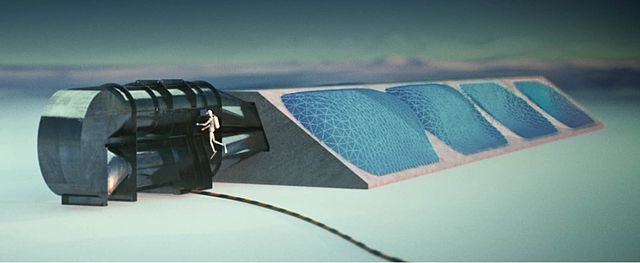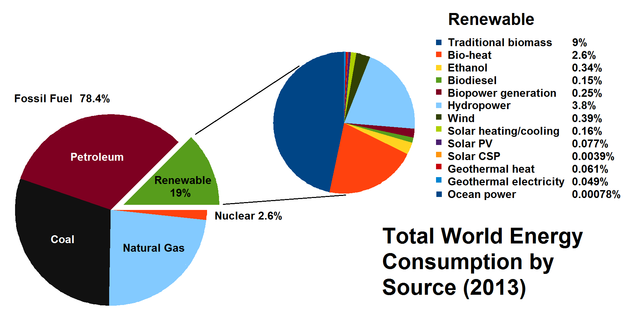ENERGY CONSUMPTION AND CLIMATE CHANGE: World Energy Sources.
Hello, dear readers. In my last post, which can be read here, I explained the radioactive sources inside the earth and world energy sources. Some of the world energy sources discussed are electrical power, solar power, and hydroelectric power. But today, I shall discuss the remaining sources of world energy such as the wind turbines, wave power, and how they all function. Then, I shall end the post on how to face the future in terms of energy consumption.
WIND TURBINES
Wind turbines take advantage of the flow of air in the atmosphere to generate electricity directly. They operate for wind speeds between approximately 10 mph (4.5 m/s) and 65 mph (29 m/s). The low-speed shaft is connected via gears to a high-speed shaft to increase the rotational speeds from approximately 50 rpm to 1200 to 1500 rpm. It is this part of the mechanism that is costly and is subject to wear and possible breakdown. The pitch or angle of the blades may be altered when the wind speeds are low or high. The turbines are also designed to rotate about a vertical axis and designed to either face the wind or face away. Most current wind turbine blades rotate on a horizontal axis, these blades being not unlike aeroplane propellers. Large turbines can have a capacity of 5 MW and can have a column height equivalent to a 20 storey building. They are usually grouped as wind farms to simplify connection to the electrical grid. Wind turbines have the disadvantage that they are not supplying energy when the wind speed is unsuitable, so that storage or an alternative supply may be required.

Air pushing against the blades of the wind turbine causes the blades to rotate such that as much as possible of the kinetic energy of the wind is converted to rotational energy. As one might expect, the energy transferred increases with wind speed and with the diameter of the blades. The maximum power that can be extracted from the air stream is given by P = 0.5d2v3 where d is the diameter of the blade or blades in metres and v is the wind speed in metres per second. The feature to notice in particular is the dependence on the velocity cubed. This means that operating between the speed limits suggested above, the power output will vary by a factor of nearly 300. Therefore, wind turbines need to be designed appropriately. The next two paragraphs below obtain the formula for 100 % efficiency of transfer.
However, not all the energy is transferred as there is still some air movement beyond the blades. Operating at optimum efficiency, the wind is only slowed by two-thirds of its original speed so that the theoretical efficiency is 0.6 and the practical efficiency is rather less. Then there are losses in the gearing system and in the transfer when generating the electrical power. Although the efficiency of a commercial turbine will be higher than for a household turbine, overall efficiency may not be much more than 0.25 (that is 25%). This does not allow for periods when the turbine is not operating due to unsuitable wind speeds or because of maintenance.
Maximum energy from a wind turbine
To calculate the energy obtainable by a wind turbine, we imagine a column of air in front of the turbine blade (or blades). We assume the blade outlines a circular area of magnitude A so that the column of air is given this cross-section together with a length L equal to vt, where v is the wind velocity and t is the period of time under consideration. We now have:
Mass of air M within the column = ρAL where ρ is the density of the air
Kinetic energy of the air = ½ (Mv2) = ½ (ρALV2).
However, v = L/t.
Hence the kinetic energy is ½ (pAv3)t.
But power P = E/t so that;
P = ½ (ρAv3)
Let us see what theoretical power this formula might give us under average conditions. We will take the density of air as 1.3 kg/m3 and assume a wind speed of 8 m/s together with a turbine blade diameter of 80 m. Then:
P = ½ (ρAv3)
= ½ (1.3 × π × 402 × 83) W
= 1.7 × 106 W or 1.7 MW
If we were to assume an overall efficiency of 25%, the turbine would produce approximately 400 kW. However, power falls away rapidly with wind speed so that, with a wind speed of 5 m/s and again an overall efficiency of 25%, the output power falls to 50 kW. This shows the importance of siting the turbines correctly.
WAVE POWER
Although there is a large amount of energy available within sea waves, so progress in harnessing the waves has been limited. The so-called Salter Duck (named after Stephen Salter of the University of Edinburgh) consists of a cam-like structure, which in small-scale tests could stop 90% of wave energy and convert 90% of that energy to electricity. Conditions in the sea are, however, more adverse. Consequently, less energy is extracted there, a complex hydraulic system is involved, and costs are high. The Duck provides a comparison for other systems.

A simpler proposed system is the oscillating water column (OWC). An incident wave builds up crests and then troughs such that a chamber (the column) is filled and emptied with water. This produces an airflow so that, with non-return valves, the air can drive an air turbine. Based on the overall principle, a number of different arrangements of the OWC have been proposed. Other systems have been tested, usually operating on similar principles to the Salter Duck in which variously designed moving parts operate hydraulic rams.
Calculating the energy that can be obtained is a complex matter. Surface water waves cannot really be described as sinusoidal as for sound and electromagnetic waves. Only a very simplified expression can be used here. The key result, assuming sinusoidal waves, is that the energy transported by a wave in a medium is proportional to the square of the amplitude and to the square of the frequency. More complex calculations involving non-sinusoidal surface waves still give the energy as the square of the height of the waves but with different dependence on frequency.
OTHER SOURCES OF ENERGY
What have been described so far are not the only methods of obtaining energy. For instance, geothermal plants have been built where high temperatures exist below ground. These can depend on a natural supply of steam to power turbines or water can be pumped into the ground to be heated by the surrounding hot magma deposits. Temperature gradients in the ocean can produce a source of energy and hence power. These depend on the internal energy of the Earth rather than on energy arising from the Sun.
FACING THE FUTURE
We have seen that traditional fuels produce large amounts of carbon dioxide and that carbon dioxide affects the global surface temperature, as it is a greenhouse gas. As the temperature rises, so there is melting of areas of ice which, if originating as land-based, will raise the sea level. In addition, there is an expansion of water with increase of temperature, which reinforces the sea level rise. As more nations of the world become fully industrialised and wealthy, so there will be an inevitable increase in energy consumption. Clearly, this needs to be kept to a minimum.

There are various ways in which consumption can be constrained. Efficiency of power production needs to be increased and there have been recent increases in efficiency of both commercial and domestic generators and heaters. But, as we have seen, there are limitations based on principles of physics as to why the efficiency of power plants is limited. Choice of fuel affects carbon dioxide production. Replacing coal and oil by natural gas reduces carbon dioxide emission and this has been achieved on a large scale in the UK and some other European countries. Where carbon dioxide is emitted, the technology is developing for capturing and storing the gas. Combined heating and power systems have been operated in certain localities (for instance, heating of housing estates by the waste energy produced by electricity power stations).
But the need for energy is ever present so the contributions from renewable energy sources need to be increased. Power from nuclear fission can produce power in large quantities but the power stations are expensive and so is decommissioning the production of radioactive waste and the possibility of a large-scale accidents reduce the popularity of the source. Power from nuclear fusion is a bit long way off.
The other approach is to use less energy. Many pieces of electronic equipment are left on standby, consuming electrical energy. The thermal insulation of most houses can be increased and this is encouraged by governments. The efficiency of car engines has increased (but the use of smaller cars would help) and so has the efficiency of aero-engines, together with lighter fuselages. Hybrid road vehicles can cut down carbon dioxide production. However, it is necessary to consider the full energy balance between production of the equipment and consumption of energy during use.
Both governments and the population at large need to play a role in keeping down energy production. International agreements prove difficult. The most notable negotiations have been those of Kyoto in 1997. The International Energy Agency (IEA) was set up in 1974 by the Organisation for Economic Co-operation and Development (OECD) to implement an international energy programme. However, progress depends on seientific input including that of physics and a commitment from us all.
SUMMARY
In all the series of my post on Energy consumption and climate change starting from this, this and this final episode, I have been able to shed more light on the following:
- The importance of solar energy for maintaining the average temperature of the Earth.
- Why the greenhouse effect occurs.
- The role of greenhouse gases, particularly carbon dioxide, in influencing global temperatures.
- That some global energy is released internally
- That global temperature has a significant effect on climate.
- The main sources of energy for human use.
- Why alternative energy sources are important and why there is a need to move away from traditional sources of energy such as coal and oil.
- How briefly such alternative energy sources such as photovoltaic cells, hydroelectric power, wind turbines and wave machines operate and;
- Why both governments and individuals need to work towards reducing energy consumption and carbon dioxide production.
REFERENCES
- https://en.wikipedia.org/wiki/Wind_turbine
- https://www.energy.gov/eere/wind/how-do-wind-turbines-work
- https://www.raeng.org.uk/publications/other/23-wind-turbine
- https://scholarcommons.usf.edu/cgi/viewcontent.cgi?article=4865&context=ujmm
- https://en.wikipedia.org/wiki/Betz%27s_law#:~:text=Modern%20large%20wind%20turbines%20achieve,to%20protect%20itself%20from%20damage.
- https://en.wikipedia.org/wiki/Stephen_Salter#:~:text=Salter's%20duck,-Main%20article%3A%20Salter's&text=While%20historic%20references%20to%20the,as%20the%20%22Edinburgh%20Duck%22.
- https://www.eia.gov/energyexplained/hydropower/wave-power.php
- https://en.wikipedia.org/wiki/Wave_power#:~:text=Wave%20power%20is%20the%20capture,wave%20energy%20converter%20(WEC).
- https://www.renewableresourcescoalition.org/alternative-energy-sources/
- https://en.wikipedia.org/wiki/International_Energy_Agency
Upvoted by GITPLAIT!
We have a curation trial on Hive.vote. you can earn a passive income by delegating to @gitplait
We share 80 % of the curation rewards with the delegators.
To delegate, use the links or adjust 10HIVE, 20HIVE, 50HIVE, 100HIVE, 200HIVE, 500HIVE, 1,000HIVE, 10,000HIVE, 100,000HIVE
Join the Community and chat with us on Discord let’s solve problems & build together.
Thanks for your contribution to the STEMsocial community. Feel free to join us on discord to get to know the rest of us!
Please consider supporting our funding proposal, approving our witness (@stem.witness) or delegating to the @stemsocial account (for some ROI).
Thanks for using the STEMsocial app, which gives you stronger support. Including @stemsocial as a beneficiary could yield even more support next time.